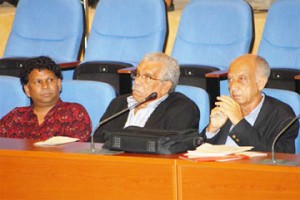Carifesta X is already fading from the headlines but it will take a much longer time before it begins to show any signs of fading from memory. At this time, however, it is not surprising that it is being subjected to analyses and evaluation. Inevitably, when a government decides to host an expensive public and international event of this magnitude it usually attracts criticisms and queries, especially when any contribution to the GDP is not immediately evident. People are asking hard questions.
The week before last we began to analyse at least one side of the matter: some issues raised particularly by writers relating to the extent to which Carifesta X was worth the effort. But we also pointed to a number of other questions to which we return in this week’s analysis, a necessary exercise to be completed before the subject retreats from these pages for the time being.

We mentioned that “Several questions will arise. Among them are issues concerning the value of the festival itself and the wisdom of Guyana playing host at this time; the huge expenditure against the national returns; the popular interests and benefits; the gains for tourism and the economy; was it a success; has it made any contribution to the arts, to the region and to the people? Was Carifesta X worth the effort and the expense?”
Where in the spectrum between wisdom and rashness is President Jagdeo’s decision to host the festival to be placed, given the state of Guyana’s infrastructure, financial poverty and burgeoning security concerns? What could have prompted the decision? Somewhere among the answers will be national pride and confidence, the seizing of an opportunity and a foreign policy advantage. He might have felt that the nation was in a state of readiness given the hosting of the World Cup Cricket and the commendations it was said to have received from the ICC for effective security arrangements. Hospitality, hotel rooms, a team of trained volunteers and a host of services were still available. There was an opportunity for those who had put out investments with expectations for the World Cup to recoup something from another occasion.
 Guyana would gain points and enhance its reputation in the spirit of regionalism. Already on the positive side of that reputation was its record of cultural leadership which includes the Guyana Prize. The nation that created the first Carifesta would now rescue it after the new Bahamas government withdrew the offer made by its predecessor. When Guyana was also courting an entry into the tourism market, it might not have been a bad idea to seize the moment.
Guyana would gain points and enhance its reputation in the spirit of regionalism. Already on the positive side of that reputation was its record of cultural leadership which includes the Guyana Prize. The nation that created the first Carifesta would now rescue it after the new Bahamas government withdrew the offer made by its predecessor. When Guyana was also courting an entry into the tourism market, it might not have been a bad idea to seize the moment.
Was the nation really able to afford it? That signal act of carpe diem would have to be funded from scarce resources in difficult times. Questions had been raised about what it really cost the country to host World Cup and the same have now been repeated. However, this involves a notable irony and a repeat of the debate about choices that was dramatised in the very Carifesta Symposia in an exchange between Walcott and Jagdeo. Will it benefit the people more to give them a road or a theatre? The debate is not new and Guyana had already made admirable responses when the Guyana Prize was established, and when there were repeated decisions to maintain it; the very decision to host the first Carifesta was a similar response. So is the President’s decision to fund a new Caribbean publishing house.
The nation found itself having to respond to the criticism that too little is spent on the development of the arts at the same time that there are demands for it to justify a large outlay of funds on the arts when so much else is in a deplorable state.
What is also of interest in this respect is the government’s policy once it set about hosting Carifesta. A conscious decision was made to seek no financial profit or even cost recovery from the festival. There is a New Carifesta Model accepted and adopted by Caricom setting out a structure for artistic gain and economic advantage with a view to removing the financial and administrative burdens from host governments. Like Trinidad and the Bahamas, Guyana decided to ignore that model and bear those burdens. All gate receipts were abolished, entry was free for all events, there was no charge for booths at the Grand Market, no effort was made to market the festival commercially or target foreign tourists.
While an opportunity was grasped in the decision to play host, was an opportunity lost in the policy not to maximise income? Did tourism pass up a potential boost? Although the statistics are yet to be assembled or released, it is already concluded that outside of visiting delegations and a number of overseas-based Guyanese, the total of tourist arrivals attracted by the event was negligible. Guyana did not go after them. The price of foreign advertising is, however, next to prohibitive, while the Caribbean media and the other Caribbean governments played a minimal role in promoting Carifesta within their own countries.
There is, however, very little mysticism surrounding the thinking and the actions of governments. Unlike what has just taken place over the question of the EPA and Cariforum, Guyana was not isolated in its policy of standing the cost of Carifesta and seeking no income from it. What Guyana did seems to be very popular among regional governments who have so far, to a man, left the New Carifesta Model safely ensconced in the Caricom Secretariat. It is probably dusted off every morning on the desks of Riane de Haas and Drs Hilary Brown and Carole Bishop, but it remains conspicuously unopened by any government.
Almost every island has been cashing in on music and jazz festivals: St Lucia, St Kitts, Tobago and various reggae summer events in Jamaica. Those, however, are driven by private commercial interests within tourism economies. The governments have obviously attached the hosting of Carifesta to foreign and domestic policy. Bahamas had the opportunity to see what Guyana did last August and have clearly decided to follow that model. The country that cancelled Carifesta for reasons of internal politics is now anxious to make amends in the eyes of the Caricom community by taking it back in 2010. Having repaired some damage to their foreign image, they seem to be thinking that there is merit in the Guyana model for domestic politics.
One element in this that interests Nassau is one of the areas of gain achieved by Georgetown. That is the involvement of the private sector. Guyana involved them meaningfully through the sponsorship of some events, which gave them a role in Carifesta and a marketing advantage through providing funding which allowed all tickets to be free. This was also a part of the large-scale popularisation of the festival which was so successful in Suriname in 2003. The idea was to involve the whole population and exclude no one. Carifesta had an impact on the popular imagination and the secretariat’s estimates based on the documented attendance at the various venues are that some 500,000 seats were filled at all the venues and events put together.
Among the gains for Guyana are the renovation of performance venues, including the most prominent Lichas Hall in Linden, and the provision of infrastructural fittings in others such as Queen’s College and Bishops. Carifesta was a catalyst and a reason for accelerated government funds into the rebuilding of the Theatre Guild. Added to these are the outcomes of the child art project, the public art project, the gains of the youth forum, the explosion of new books, the exposure of local writers to an audience and of the local audience to foreign books, foreign writers and visiting theatre. Seven hundred persons were trained in areas of technical theatre, running and supporting several venues during Carifesta, and they are now available as trained personnel to sustain theatre and performance in several regions across Guyana.
Among the greatest failings during the festival were the ticket distribution fiasco, the overcrowded feel of the programme and the many unexpected programme changes to add to the lack of tourism arrivals and advancement in the industry. But the secretariat had the capacity to quickly abandon the ticketing scheme once it was not working. Despite all those, there can be a clear verdict in favour of deeming the festival a success. The effort to leave long-term benefits should also help to justify the expenditure.
It becomes increasingly difficult to question the investment of funds and at the same time deplore the failure of the government to give tangible support and funding to the arts.




